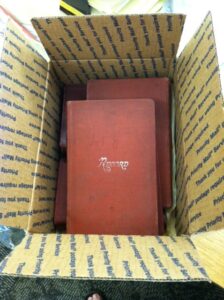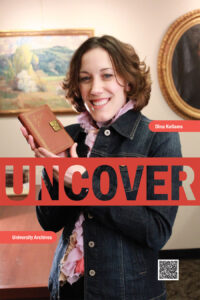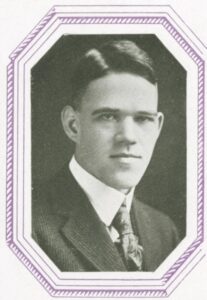Can I share with you one of my favorite archival sights?

Earlier this year, I received an email from a woman in Virginia stating that the diaries of her friend’s father – primarily dating from his time as an IU student in the late 1910s – had found their way into her possession and she wondered if we would be interested in them?

Yes yes yes yes! I mean, have you seen this picture of me hanging in the library somewhere? See what’s in my hands?
I like diaries. It’s not – necessarily – that I am nosey. Rather, I like how they fill in a person’s story, whether it be the writer or the individuals written about. When I come across mentions or descriptions of student hangouts or campus traditions or faculty, I’m over the moon! And I love how they provide a personal perspective on major world events.
So, when that box above arrived, I forced myself to set it aside until I could spend some time with the diaries because I knew they’d be a time suck. And because I like to share, I decided to immediately write a finding aid so that you all could also have the opportunity to enjoy them!
_______________________________________________________________________________

Hailing from Williamsport, Indiana, native Hoosier William Raimond Ringer entered Indiana University in 1916. As a student, he was very active in campus activities, and served as an officer for several campus groups. The small collection of papers held by the Archives consists chiefly of diaries maintained by Ringer while he was an IU student. He was devoted to writing in his journals – about what classes he had that day, what they did, where he ate, who he saw and talked to, etc.
Ringer’s time at IU coincided with World War I. Although he originally planned to leave college to teach, at the last minute he turned down his teaching job so that he could return to IU and join the Students’ Army Training Corps when it was formed in 1918. According to the 1919 Arbutus, with the SATC,
the government was to practically take over for military purposes the organization and equipment of every college able to muster a sufficient number of students for military drill. This surrender on the part of the colleges to the government control was to be voluntary, and the relation between the government and the college was to be a matter of contract. A duty rested upon the colleges to provide suitable barracks and subsistence for the members of the Student’s Army Training Corps, in addition to academic instruction, the colleges to be reimbursed as agreed upon in the contract with the governemnt.
Indiana University was one of the first to make this contract, and began early to make plans for the housing and feeding of the great number of soldiers who were to be trained here.

On October 3, 1918, Ringer and his friends were divided into SATC companies and he was told he would be living at the Delta Tau House, aka “Barracks 1.” He wrote in his journal, “I am in the army – and tonight is my first night. I am glad yet I don’t like the bunch here at all. All roughnecks at the house.” Ringer continued to log his experiences – including a brush with the Spanish flu, which I previously wrote about – with impressive regularity. Thankfully, he never did get pulled into the war overseas, as on November 27 they received word that the S.A.T.C. was to be disbanded within the month and he moved out of the barracks.
Ringer continued writing in his diary through March of his senior year. Rather sad that he didn’t finish up with his accounts at IU, but to date, this is nonetheless probably the most complete account of student life we have through a diary keeper. (Update! I heard from the donor that she has the remaining IU entries and they were waiting on my desk this AM!) While the bulk of the collection consists of these diaries, there is also one volume holding copies of his outgoing correspondence for a short period, report cards, as well as some of his poetry and other writings (he was active in the Writing Club on campus).
Of course, one cannot read a person’s diary and not develop an impression of the writer. With William, even as a young college student, it seems he was very serious and the shenanigans of the other students tended to exasperate him. I don’t know whether he said anything to the individuals in person, but he could be scathing in his opinions of dates, classmates, and professors.
So, at your leisure, check out the finding aid and let us know if you would like to see the collection!
1 Comment
This is so interesting, I believe that it would be a great interest to everybody present in the university to read about it some hundred years ago…